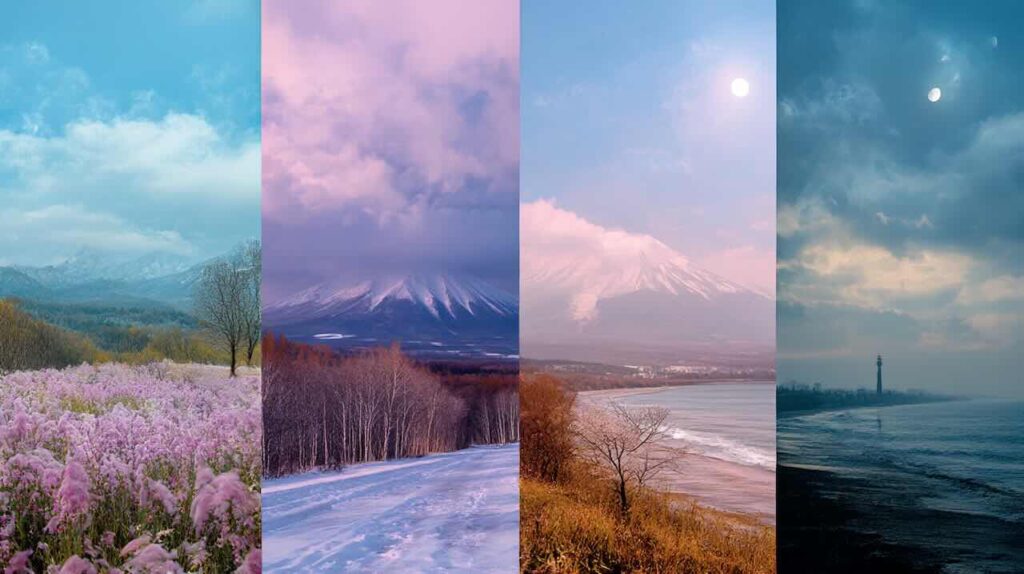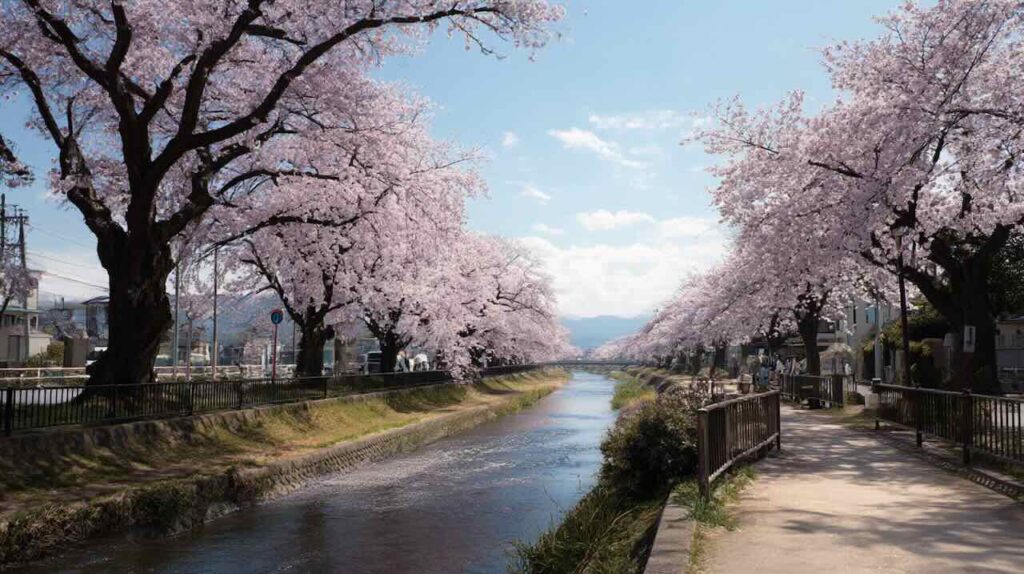Introduction: A Different Kind of Japan
When people think of Japan’s four seasons, they often imagine Tokyo’s cherry blossoms in March, Kyoto’s vibrant autumn leaves, and hot, humid summers. But Hokkaido, Japan’s northern frontier, follows a very different seasonal rhythm.
Here, spring arrives late, summer vanishes quickly, autumn flashes by in brilliant colors—and winter seems to last forever. In this article, we’ll explore why Hokkaido’s seasons are so distinct, what shapes this unique climate, and how life on the island adapts to its long, powerful winter.
Note: For reference, we’ll primarily focus on Sapporo, Hokkaido’s largest city. The timing varies slightly across southern, central, and northern Hokkaido.
A Quick Look at Hokkaido’s Compressed Warm Seasons
Spring (Late April – May): From Snowdrifts to Blossoms in Weeks
In most of Japan, spring arrives in March. In Hokkaido, snow often still blankets the landscape well into April.
- Cherry blossoms bloom between late April and early May.
- Snow may linger on the ground until mid-April in colder years.
- New greenery finally appears in late May or early June.
Spring here is more of a rapid transition than a slow awakening. Winter releases its grip almost suddenly, and within weeks, trees bud and flowers bloom. Hokkaido’s famous kanhizakura (cold-tolerant cherry blossoms) mark this brief but stunning season.
Summer (Late June – Mid-August): Cool, Comfortable, and All Too Brief
While much of Japan swelters under intense summer heat, Hokkaido’s summer is refreshingly cool:
- Daytime highs range from 25°C to 30°C (77°F to 86°F).
- Humidity stays low, making air conditioning unnecessary for many.
- Heatwaves over 30°C have become more common in recent years due to climate change.
Beach season begins in May and can last until early fall, but by mid-August, you’ll already feel the cool hint of autumn creeping in.
Fall (Late August – Early October): The Fastest Season
Hokkaido’s fall is breathtaking but fleeting:
- Brilliant red and gold foliage appears as early as late August in mountain areas.
- Peak foliage in Sapporo typically occurs in mid-September to early October.
- Temperatures drop rapidly after October.
Unlike mainland Japan, where fall extends into November, Hokkaido’s autumn rushes by in a matter of weeks—one of Japan’s earliest and most dramatic displays of seasonal color.
Why Is Winter So Long in Hokkaido?
Winter (Late October – Late March): A Way of Life, Not Just a Season
In Hokkaido, winter dominates the calendar:
- First snowfall: Late October to early November.
- Permanent snow cover: From late November onward.
- Coldest period: January–February, often falling below –10°C (14°F).
- Snowmelt: Not fully gone until April in colder areas.
For many residents, winter lasts five to six months. But it’s not all hardship—winter brings world-class skiing, snowboarding, hot springs, and cultural events like the famous Sapporo Snow Festival.
Why Are Hokkaido’s Seasons So Different from the Rest of Japan?
1. Northern Latitude
Hokkaido sits at 41°–45° N latitude—closer to parts of Europe and North America than Tokyo.
- The sun sits lower in the sky, limiting heat even during warmer months.
- Spring arrives later, and fall begins sooner.
- Days grow short quickly in autumn.
2. Powerful Siberian Weather Systems
In winter, cold, dry air masses sweep from Siberia across the Sea of Japan.
- When this air hits moist sea air, it creates heavy snowfalls—especially on Hokkaido’s western side.
- Temperatures remain stubbornly low for months.
- Cold air often gets trapped over the island, keeping spring at bay.
3. The Absence of a Rainy Season
Unlike much of Japan, Hokkaido doesn’t experience the tsuyu (rainy season) in June and July.
- This absence means that seasonal transitions happen quickly.
- Once spring arrives, the island jumps almost directly into summer without prolonged rain delays.
Seasonal Overview at a Glance
| Season | Timing | Characteristics |
|---|---|---|
| Spring | Late April – May | Sudden snowmelt, rapid blooming |
| Summer | Late June – Mid-August | Comfortable, short, and dry summer |
| Fall | Late August – Early October | Brilliant but brief autumn foliage |
| Winter | Late October – Late March | Long, snowy, cold, and defining |
Note: Areas like Hakodate and southern Hokkaido experience a slightly milder, more typical Japanese seasonal pattern.
How Hokkaido Residents Experience the Seasons
In Hokkaido, people often feel the changing seasons through:
- Shifts in wind direction and ocean currents
- The return of seasonal seafood like salmon and sea urchin
- Local festivals such as Yuki Matsuri (Snow Festival) or autumn harvest events
- The rhythm of snow removal and winter preparations
- Subtle changes in daylight and temperature rather than sudden visual cues
For many locals, the year revolves around preparing for and enduring the winter months—which are both challenging and culturally rich.
Conclusion: In Hokkaido, Winter Is King
Hokkaido’s seasonal cycle is not one of balance, but of extremes. Spring, summer, and fall are brief bursts of change, while winter dominates life for nearly half the year.
But far from being harsh or lifeless, Hokkaido’s winter offers unique beauty, cultural depth, and outdoor opportunities unlike anywhere else in Japan. If you embrace its rhythm, you’ll discover a quiet strength and enduring charm that defines life on Japan’s northern frontier.
Whether you’re planning a visit or simply curious about Japan’s diverse climate, understanding Hokkaido’s seasonal heartbeat is essential to appreciating its unique character.


